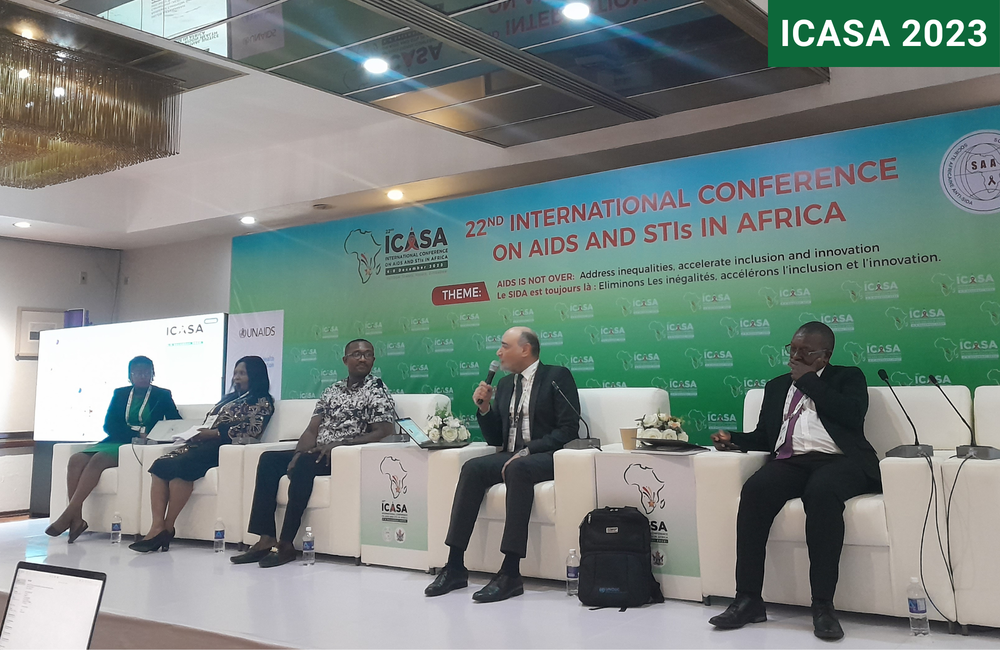
Despite 15.5% of prisoners in sub-Saharan Africa having HIV, incarcerated people have been largely left behind in the fight against HIV, the 22nd International Conference on AIDS and STIs in Africa (ICASA 2023) taking place in Harare, Zimbabwe, heard last week.
Speaking at a special session on promoting prison health reform in Africa, Doreen Namyalo, the sub-Saharan Africa Director at Penal Reform International, told the conference that the HIV burden in Zambian prisons was 27%, 37% in Malawi, 17% in Lesotho, 15% in Uganda and 8% in Kenyan prisons.
Furthermore, while the few prison health interventions have mainly focused on men, incarcerated women have the highest prevalence of HIV. In Malawi, 50% of female prisoners have HIV compared to 30% of males. In Lesotho, 62% of female prisoners have HIV versus 31% of male prisoners. In Uganda, 23% of female prisoners compared to 13% of male prisoners, and in Kenya, 19% of female prisoners versus 6% of male prisoners had HIV.
Factors contributing to the high prevalence rates include the absence of prevention materials like condoms, PrEP and harm reduction; sexual violence and assaults; and poor nutrition, which leads to some people exchanging sex for food.
Namyalo explained that the situation was exacerbated by overcrowding. For instance, Uganda has a prison capacity of 19,000, but currently, there are over 74,000 people in prisons. Similarly, Malawi has a prison capacity of 7,000 but over 16,000 prisoners.
There is limited access to healthcare in prisons. Uganda has 1,149 healthcare workers for all its prison population, while Malawi has only one doctor for every 28 prison facilities.
Despite the limitations, some HIV prevention interventions are already happening in African prisons.
A football-based intervention study designed to improve HIV and sexual health knowledge and promote positive attitudes towards women amongst male inmates in southern Africa trained 126 inmate coaches as peer educators, who in turn educated 2920 prisoners using over 1000 football sessions with integrated health messaging.
Matthew Wolfe from Tackle told the conference that from 2019 to 2022, the study used football as a means of social change, engaging prisoners in a way that they could enjoy, remember, and understand. The project was successful in spreading information about HIV among inmates, as 80% of them reported sharing it with others. In addition to HIV and sexual health messaging, 1200 HIV tests were administered.
Prisoners who volunteered as coaches in 14 correctional facilities in Zambia, Zimbabwe, and Malawi received four-day training courses three times a year, which focused on basic knowledge about HIV and sexual and reproductive health rights. The coaches then disseminated this information in a fun way during football sessions with other prisoners.
At the end of the study, comprehensive knowledge of HIV increased from 35% to 51%, and knowledge of STIs improved from 52% to 65%. At the same time, the question “Should a girl be able to refuse unwanted sex from her husband or boyfriend?" saw an increase in correct answers from 76% to 88%, while responses to the statement “Having sex with many women is a sign of manhood” saw correct answers increase from 64% to 76%.
Attitudes towards condom use, well-being and HIV testing also changed.
Speaking to aidsmap, Wolfe said that out of the 1200 individuals tested for HIV, 15 received a new positive diagnosis and were linked to care. It's important to note that prisoners are tested for HIV when they enter the prison, so these 15 individuals likely contracted the virus while they were in jail.
"Over the course of the project, we had prisoners getting in touch with us once they'd been released, asking if they could still deliver the sessions in their communities as an opportunity to reintegrate back into community life," said Wolfe.
Another study was carried out by Prisca Sikana and colleagues from the Southern Africa Network Of Prisons across 19 prisons in Eswatini, Zambia and Zimbabwe to identify the health challenges young people face in correctional settings. It documented their health practices, analysed their attitudes and knowledge, and assessed the availability of youth rehabilitative services in prisons and remand facilities. The majority of prisoners were males under the age of 24.
The study revealed that in all three countries, an average of 91% of respondents were aware of the availability of sexual and reproductive health services, including HIV testing and counselling, in prison. However, the provision of condoms and contraception was very low: in most countries within their region, legislation does not allow prison authorities to provide condoms or lubricants, and those that are provided are from civil society.
"As we move towards the 2025 and 2030 UNAIDS goals, we also have to think about the 10-10-10 targets because stigma and discrimination around those incarcerated is one reason why we see the very low level or even no funding going towards prisoners as a key population," said Dr Cedric Pulliam, a key populations advisor at PEPAR. "We have to centre prisoners and those incarcerated in the global and regional HIV response, and we have to continue to be a voice for those who don't have a voice because they are incarcerated.”
Special session: Promoting criminal justice reform and prison health reform in Africa. 22nd International Conference on AIDS and STIs in Africa, Harare, 2023.
Wolfe M et al. Improving HIV knowledge and gender-based attitudes amongst male inmates through football in correctional facilities in Zambia, Malawi and Zimbabwe. 22nd International Conference on AIDS and STIs in Africa, Harare, abstract WEAD0703, 2023.
Sikana S et al. Promoting human rights, quality health, and wellbeing for youth prison populations. 22nd International Conference on AIDS and STIs in Africa, Harare, abstract WEAD0702, 2023.
